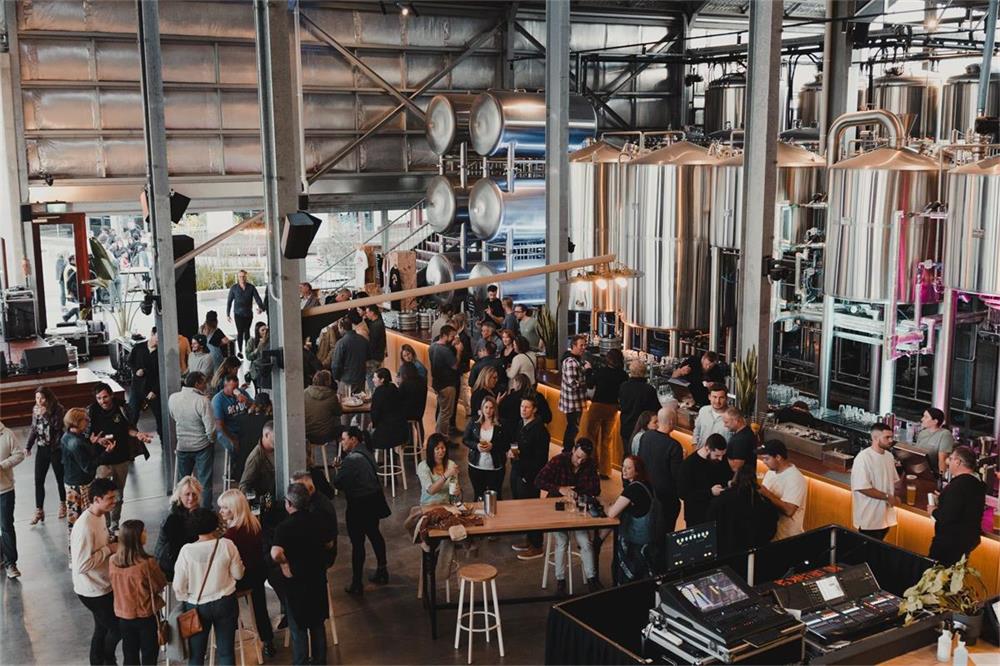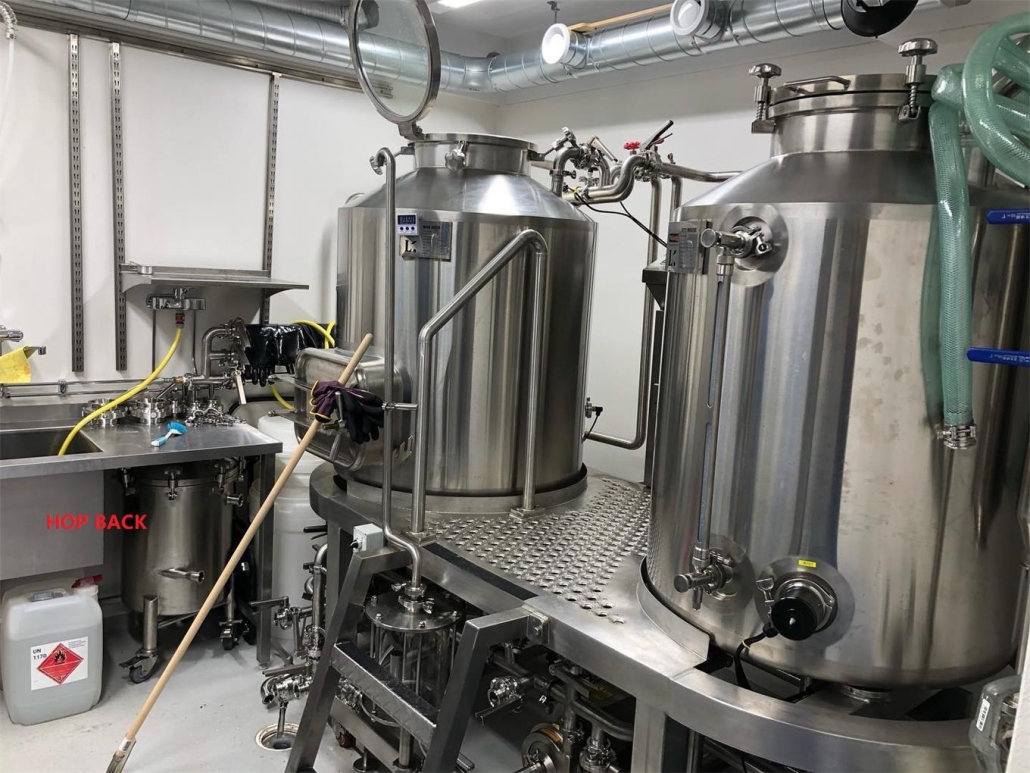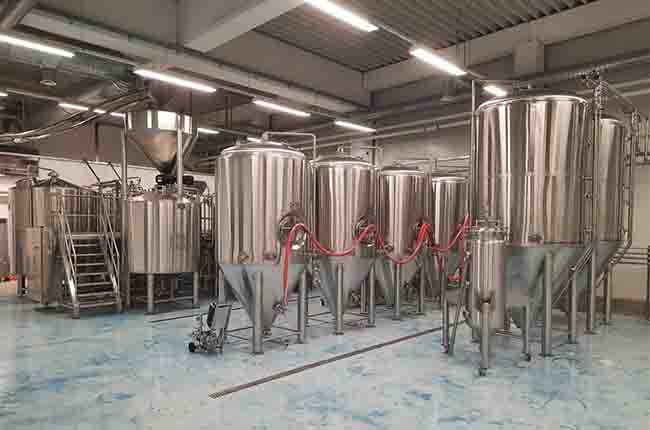4 BBL Mash Tun
A 4 BBL Mash Tun is a critical piece of brewing equipment used to create the sweet wort required for beer production through the mashing process. This guide provides craft breweries and homebrewers an in-depth look at 4 BBL Mash Tun selection, sizing, design, operation and maintenance.
Overview of 4 BBL Mash Tuns
A mash tun is a vessel used for mashing, the process of steeping crushed malt in hot water to convert starches into fermentable sugars. The sweet liquid extracted, called wort, is boiled with hops before fermentation into beer.
Mash tuns are made from stainless steel or copper to resist corrosion. They contain a perforated false bottom to filter the wort while retaining the grain bed. The capacity is sized based on the target batch volume and brew house scale.
Key details:
- Capacity – 4 BBL or 120 gallons of wort per batch
- Material – Stainless steel or copper
- Contains false bottom and sparge arms
- Sized for mash volumes of 4 barrels or 480 pounds of grain
- Designed to maintain temperatures for starch conversion
- Part of the brewhouse system along with the brew kettle
With high quality construction and proper operation, a 4 BBL mash tun provides the foundation for efficiently producing exceptional beer recipes time after time.

4 BBL Mash Tun Equipment Guide
Commercial mash tuns for 4 BBL breweries are available in different designs and configurations to match brew house requirements and budgets.
Types of 4 BBL Mash Tuns
| Type | Description |
|---|---|
| Single Infusion | Basic mash tun with single temperature rest conversion |
| Multi-Rest | Advanced mash program capability with HERMS/RIMS |
| Electric | Integrated electric heating elements for mash temperature control |
| Gas Fired | Uses gas burner heating system |
| Steam Jacketed | Steam coils or jacket for precise mashing temperature |
Mash Tun Capacity Specifications
| Detail | Typical Range |
|---|---|
| Total Volume | 150 to 200 gallons |
| Batch Size | Up to 4 BBL wort |
| Mash Volume | 120 to 150 gallons |
| Grain Capacity | Up to 650 pounds |
Mash Tun Design and Customization
Mash tun designs can be customized with different options and add-ons:
| Element | Choices |
|---|---|
| Shape | Square or round |
| Height-to-width Ratio | From short and wide to tall and narrow |
| Material | 304 or 316 Stainless Steel, Copper |
| Finish | Polished or brushed interior |
| Insulation | Single or jacketed insulation |
| Heating System | Electric, gas, steam |
| False Bottom | Perforated or slotted |
| Sparge Arms | Fixed or rotating |
| Level Indicators | Side glass, floating ball, point sensors |
| Controls | Manual, automatic, touchscreen |
Mash filters, automated rakes, extended conditioning capability, and custom fabrication can also be incorporated as needed.
Mash Tun Layout and Spaces
A 4 BBL mash tun system requires sufficient space for:
- Front access for raking and mixing
- Sparge water lines and heating equipment
- Wort runoff and transfer lines
- Control panels and power supply
- Cleaning and maintenance access
Brewing Process Using a 4 BBL Mash Tun
The typical mashing and lautering process with a 4 BBL system involves:
- Heating strike water and transferring to the mash tun
- Mixing in crushed grains to reach target mash temperature
- Maintaining optimal temperature for starch conversion
- Recirculating wort for clarity and efficiency
- Raising temperature for mash-out
- Sparging to rinse sugars from the grain bed
- Runoff of sweet wort to the brew kettle
Efficiency up to 75-80% can be achieved with proper configuration and operation.
Selecting and Buying a 4 Barrel Mash Tun
Choosing an appropriately designed, sized and priced mash tun is critical for 4 BBL breweries.
Key Suppliers and Price Ranges
| Supplier | Price Range |
|---|---|
| JV Northwest | $8,000 to $15,000 |
| Premier Stainless | $10,000 to $20,000 |
| Rolec Craft Brewing | $15,000 to $30,000 |
| Specific Mechanical | $8,000 to $25,000 |
| Psycho Brew | $10,000 to $35,000 |
| Alternative Beverage Equipment | $15,000 to $40,000 |
Pricing varies based on features, customization, brand and materials. Grain handling equipment and installation will be additional costs. Buyers should get multiple quotes before purchasing.
How to Select the Best 4 BBL Mash Tun
Important criteria for selection include:
Performance Factors:
- Temperature accuracy and uniformity
- High lautering efficiency rating
- Fast heating and response times
- Fits targeted beer recipes and wort parameters
Quality and Design:
- Heavy duty stainless steel interior and exterior
- Integrated stepped mash program controller
- Advanced rake design for grain bed mixing
- Fully enclosed steam jacket
Service and Support
- Responsiveness to quote requests
- Custom engineering and design services
- Provides operator training
- Availability of spare parts and service
Reputation and Experience
- Specializes in small brewhouse systems
- Years of experience building mash tuns
- Positive customer reviews
- Craft brewery client references
Prioritizing these criteria simplifies the decision process and ensures optimal system performance for years to come. Do not focus purely on price – quality is well worth the investment.
Installation, Operation and Maintenance
Once purchased, proper installation, operation and preventative maintenance ensures maximum efficiency and longevity of a 4 BBL mash tun.
Installation Considerations
- Floor space and layout
- Grain handling equipment
- Electrical and utility requirements
- Integrations with brew deck and fermentation
- Local building codes and permits
Standard Operating Procedures
- Volume calculations for strike and sparge water
- Detailed mash recipes for each beer type
- Heating water to temperature setpoints
- Monitoring and recording all parameters
- Cleaning cycles and sanitization
Maintenance Best Practices
| Task | Frequency |
|---|---|
| Inspect steel surface | Monthly |
| Replace seals and gaskets | Annually or as needed |
| Inspect insulation | Annually |
| Check heating system | Quarterly |
| Clean sensors | As needed |
| Leak checks | Monthly |
| Tune temperature control | As needed |
Avoiding deferred maintenance and following manufacturer guidelines preserves tun integrity.
Comparing 4 BBL Mash Tun Models
When evaluating options from different suppliers, there are several key factors potential buyers must weigh:
| Consideration | Pros | Cons |
|---|---|---|
| Stainless vs Copper | Resists corrosionBetter seals | ExpensiveDifficult fabrication |
| Electric vs Gas Heat | Precise controlCleanerEfficient | Higher energy costsComplex system |
| Steam vs Electric | Very accurate temperaturesLess power needed | Slow heating timesCondensationLicensing |
| Automation | ConsistencyLabor savingData tracking | Additional costComplexity |
| Square vs Round | Better drainingMaximizes volumeEasier fabrication | Limited customization Can have dead spaces |
There are always tradeoffs to consider based on production goals, growth plans, budgets and brewing philosophy. Finding the right balance requires careful introspection of constraints and priorities before committing to a major capital purchase. With good planning and foresight, upgrading in the future as capacity expands can also mitigate compromises today. Do not rush this critical decision without thoroughly researching how each attribute contributes to long term success.

FAQ
Q: What size mash tun do I need for a 4 BBL brewhouse?
A: A minimum 150 gallon mash tun is recommended, with 180+ gallons preferred to allow adequate room for mash circulation and grain bed expansion during lautering. This safely supports standard 4 BBL batch sizes.
Q: Should I choose stainless steel or copper construction?
A: Stainless steel is more durable, easier to maintain, and provides better temperature stability. Copper offers beautiful aesthetics but requires intensive cleaning and polishing. Stainless is best for production breweries while many small brewpubs still opt for copper’s visual appeal.
Q: What level of automation should I get?
A: Fully automated mash tuns simplify operation and ensure repeatability. However, manual systems with upgraded heating control provide good functionality at a lower price point for budget conscious brewers. Finding the right balance depends on production goals, growth plans and financial constraints. Advanced features can always be added later as capacity expands.
Q: Is a rake system or mash filter recommended?
A: Rakes provide good lautering performance for most breweries. Filters offer faster runoff times and greater efficiency but come at a steep price premium. Assess needs carefully before making this large investment.
Q: Should I fabricate my mash tun in-house to save money?
A: Attempting construction as a DIY project or hiring a non-specialized metal shop both carry substantial risk and is generally not advisable. The engineering expertise and brewing experience of a professional mash tun fabricator is strongly recommended to ensure optimal system functionality and safety.
Conclusion
This guide covers key considerations when researching, selecting and operating a 4 BBL mash tun for professional breweries or ambitious homebrewers. Sufficient capacity, advanced heating control, quality fabrication and precise design is essential to maximizing brewhouse efficiency. While the initial investment is substantial, the right mash tun optimizes wort production for manufacturing exceptional beer styles that delight customers and grow the business for years to come. For further assistance assessing options or developing an RFP for your brewery, please contact an industry expert today.
Additional FAQs for 4 BBL Mash Tun
1) What grain-to-water ratio works best in a 4 BBL mash tun?
- Typical ranges are 1.2–1.6 qt/lb (2.5–3.3 L/kg). For high-gravity mashes near the tun’s limit, lean toward thinner mashes (1.5–1.6 qt/lb) to improve flow and conversion.
2) How much headspace should I plan for in a 4 BBL mash tun?
- Aim for 15–25% freeboard above mash volume to accommodate grain bed expansion, vorlauf turbulence, and sparge hardware. For 4 BBL, that often means 170–200 gal total volume.
3) What lauter runoff rate should I target to avoid a stuck mash?
- Start at 0.75–1.25 gal/min per barrel of batch size (≈3–5 gal/min for 4 BBL), stabilizing bed compaction before increasing. Monitor differential pressure and clarity; adjust rakes (if equipped) minimally.
4) Is HERMS or RIMS more suitable at the 4 BBL scale?
- Both work. HERMS provides gentler, more uniform heating and reduces scorching risk; RIMS offers faster step response but needs careful flow/temperature control to protect enzymes. Many 4 BBL systems favor HERMS for consistency.
5) What insulation and jacket options most impact mash temperature stability?
- 50–75 mm polyurethane/PIR insulation plus steam or dimple-jacketed heating yields ±0.5–1.0°F stability. Electric elements can match this if watt density is appropriate and control loops are well-tuned.
2025 Industry Trends: 4 BBL Mash Tun
- Precision thermal control: Wider adoption of multi-zone jackets, RTD arrays, and tuned PID loops delivering tighter ±0.5–1.0°F mash stability.
- Energy efficiency: Heat recovery (wort-to-CLT/HLT), thicker insulation, and VFD-controlled pumps to reduce utility intensity.
- Hygienic design upgrades: Orbital-polished interiors (≤0.6–0.8 μm Ra), crevice-free fittings, and improved CIP spray coverage validation even on small-scale tuns.
- Compact footprints: Skid-mounted 4 BBL brewhouses with integrated HLT/CLT utilities and swing piping to accelerate turns.
- Supply chain normalization: Standard 4 BBL mash tun SKUs shipping faster than in 2022–2023; custom automation still adds lead time.
2025 Benchmarks for 4 BBL Mash Tun Buyers
| Metric | Typical 2025 Value | Notes |
|---|---|---|
| Total volume | 170–200 gal | Allows 15–25% headspace |
| Practical grain capacity | 550–650 lb | Depends on crush and grist |
| Mash efficiency | 75–82% | With proper crush, pH, runoff |
| Interior finish (Ra) | ≤0.8 μm (food/bev) | ≤0.6 μm premium |
| Insulation thickness | 50–75 mm | Reduces heat loss |
| Temp stability (rest) | ±0.5–1.0°F (±0.3–0.6°C) | With tuned controls |
| Typical price (USD) | $8,000–$25,000+ | Spec/options dependent |
| Lead time | 6–14 weeks | Custom adds 4–8 weeks |
Sources: Brewers Association (2024–2025) benchmarking/QA briefs; MBAA Technical Quarterly; ASBC guidance; vendor spec sheets/P&IDs; ProBrewer practitioner reports
Latest Research Cases
Case Study 1: Step-Mash Control Improves Extract on a 4 BBL System (2025)
Background: A nano brewery reported variable OG and lower-than-expected brewhouse efficiency (≈74%) on mixed-grist lagers.
Solution: Added HERMS coil with dual RTDs (mash bed and HEX outlet), tuned PID, and standardized step holds (e.g., beta 144°F → alpha 158°F → mash-out 168°F). Adjusted mill gap and lauter rate SOP.
Results: Efficiency increased to 80–81%; OG variance narrowed by 35%; mash rest temp deviation reduced to ±0.6°F; overall mash time unchanged.
Case Study 2: Insulation + CIP Validation Cuts Turn Time (2024)
Background: Long heat losses and inconsistent cleaning extended cycle times between back-to-back 4 BBL brews.
Solution: Upgraded shell/head insulation to 60–70 mm PIR, validated spray coverage with riboflavin tests, and resized CIP pump to meet 1.5–2.0 bar at spray device.
Results: Heat loss during 60-min rest fell by ~45%; mash temp corrections decreased; CIP time reduced by 18 minutes per cycle; no increase in micro indicators.
Expert Opinions
- John Mallet, Brewing Operations Consultant; author of Malt: A Practical Guide
“Repeatable mash outcomes at the 4 BBL scale come from measured fundamentals—crush, pH, temperature uniformity, and a controlled runoff profile.” - Dr. Tom Shellhammer, Professor of Fermentation Science, Oregon State University
“Uniform thermal control in the mash is foundational. Multi-point sensing and tuned PID loops improve fermentability and sensory stability down the line.” - Laura Ulrich, Senior Brewer and Pink Boots Society leader
“Design for cleanability. If manways, rakes, and ports are easy to access and your spray coverage is validated, your 4 BBL mash tun will run faster and cleaner.”
Practical Tools and Resources
- Brewers Association – Quality, safety, and benchmarking tools: https://www.brewersassociation.org
- Master Brewers Association of the Americas (MBAA) – Technical resources on mash/lauter design: https://www.mbaa.com
- ASBC Methods of Analysis – Mash pH, extract, beta-glucan tests: https://www.asbcnet.org
- ProBrewer – 4 BBL system design threads and calculators: https://www.probrewer.com
- Bru’n Water – Mash chemistry/pH spreadsheet: https://sites.google.com/site/brunwater
- Brewer’s Friend / Brewfather – Recipe and brewhouse efficiency tracking: https://www.brewersfriend.com | https://brewfather.app
Sources and further reading:
- Brewers Association 2024–2025 benchmarking and QA briefs
- MBAA Technical Quarterly on step mashing, lautering, and CIP validation
- ASBC methods for mash performance and wort quality
- Vendor spec sheets/P&IDs for 4 BBL mash tuns and HERMS/RIMS configurations
- Practitioner case reports on ProBrewer regarding insulation, rakes, and runoff control
Last updated: 2025-09-08
Changelog: Added 5 targeted FAQs; inserted 2025 buyer benchmarks table; provided two recent case studies; included expert viewpoints; compiled practical tools/resources with authoritative links.
Next review date & triggers: 2026-01-15 or earlier if BA/MBAA/ASBC publish new mash/lauter guidance, significant lead-time/price shifts occur, or new small-scale control technologies change best practices.
Share this entry
Interested in learning more about Brewing Systems including additional details and pricing information? Please use the form below to contact us!
YOLONG BREWERY EQUIPMENT FAQS
- Commercial Brewery / Craft Brewery / Microbrewery / Nanobrewery
- What is The Difference Between Craft Beer and Industrial Beer?
- The Bespoke Differences In Custom Brewing Systems
- Everything You Need to Know About Kettle Souring
- How to Choose Brewing Equipment for Your business?
- How To Choose The-Best Partner To Build Your Commercial Microbrewing System?
- Two Detection Sensors That You Need To Use In Your Brewhouse System
- Remote Control Applications in Brewing Equipment/How does it work?
- How To Clean Your Brand New Brewery Tanks?

